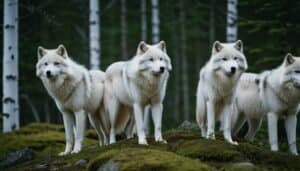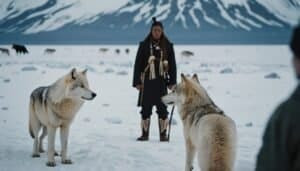Introduction
Arctic wolf conservation is critical for maintaining ecological balance and biodiversity in the Arctic regions. Governments can play a significant role by implementing various incentives and support mechanisms
This article explores financial incentives, legislative support, public awareness campaigns, collaborations with NGOs, and more to promote the conservation of Arctic wolves. We will also delve into economic benefits, research initiatives, community involvement, and international cooperation
Government Incentives and Support for Arctic Wolf Conservation
Conserving the Arctic wolf is a crucial task that requires coordinated efforts from various stakeholders. Governments play a pivotal role in this by offering incentives and support to encourage conservation efforts
This section will explore different strategies, including financial incentives, legislative support, public awareness campaigns, and collaboration with NGOs, to promote the conservation of Arctic wolves
Financial Incentives for Conservation
One of the most effective ways governments can support Arctic wolf conservation is through financial incentives. Grants and subsidies can be provided to organizations and research institutions dedicated to studying and protecting these animals
For instance, funding can cover the costs of habitat restoration projects, monitoring wolf populations, and developing conservation technologies. The U.S. government, through agencies like the Fish and Wildlife Service, has previously provided financial support for endangered species conservation, which could serve as a model for Arctic wolves
Additionally, governments can establish conservation funds specifically earmarked for Arctic wolf projects. These funds can attract private donations and corporate sponsorships, multiplying the available resources for conservation efforts
Tax incentives for businesses and individuals who contribute to these funds can further enhance participation and investment in Arctic wolf conservation
Legislative Support for Conservation Efforts
Legislation plays a crucial role in protecting Arctic wolves and their habitats. Governments can enact laws that create protected areas where Arctic wolves can thrive without the threat of human encroachment
For example, the establishment of wildlife refuges and national parks in Arctic regions can provide safe havens for these animals. The Endangered Species Act (ESA) in the United States has been instrumental in protecting various species, and similar legislation can be tailored to safeguard Arctic wolves
Moreover, governments can implement regulations that limit activities harmful to Arctic wolf populations, such as mining, oil drilling, and unregulated hunting. By enforcing strict penalties for violations, governments can ensure compliance and deter actions that could endanger the wolves
International agreements, such as the Convention on International Trade in Endangered Species (CITES), can also be leveraged to protect Arctic wolves from illegal trade and exploitation
Public Awareness Campaigns
Raising public awareness is essential for gaining widespread support for Arctic wolf conservation. Governments can launch educational campaigns that highlight the importance of Arctic wolves to the ecosystem and the threats they face
These campaigns can be disseminated through various media channels, including social media, television, and print
Educational programs in schools can also play a significant role in fostering a conservation mindset among younger generations. By incorporating Arctic wolf conservation into the curriculum, students can learn about biodiversity and the importance of preserving natural habitats
Public service announcements and community events can further engage citizens and encourage them to participate in conservation efforts
Collaboration with NGOs
Non-governmental organizations (NGOs) are critical partners in conservation efforts, bringing expertise, resources, and grassroots connections. Governments can collaborate with NGOs to implement conservation programs, conduct research, and engage local communities
For instance, partnerships with organizations like the World Wildlife Fund (WWF) or the International Union for Conservation of Nature (IUCN) can enhance the effectiveness of conservation initiatives
Joint efforts can include habitat restoration projects, anti-poaching campaigns, and community-based conservation programs. By leveraging the strengths of both governmental and non-governmental entities, conservation efforts can be more comprehensive and impactful
Additionally, governments can support NGOs through funding, technical assistance, and policy advocacy, ensuring that these organizations have the resources they need to protect Arctic wolves effectively
Economic and Research Initiatives
Economic and research initiatives are fundamental to advancing Arctic wolf conservation. By providing tax breaks for conservation supporters, funding research on Arctic wolf habitats, and establishing protected areas, governments can create a robust framework for effective conservation efforts
Tax Breaks for Conservation Supporters
Tax incentives can be a powerful tool for encouraging businesses and individuals to support Arctic wolf conservation. Governments can offer tax deductions or credits to companies that invest in conservation projects or adopt sustainable practices that benefit Arctic wolf habitats
For example, corporations that fund habitat restoration initiatives or contribute to conservation funds could receive significant tax relief, making it financially advantageous to support these efforts
Individuals can also be incentivized through tax breaks for donations to conservation organizations or participation in volunteer programs aimed at protecting Arctic wolves. Such measures can increase the pool of resources available for conservation activities and foster a culture of environmental responsibility among businesses and citizens
Funding Research on Arctic Wolf Habitats
Research is essential for understanding the needs and behaviors of Arctic wolves and for developing effective conservation strategies
Governments can allocate funds to universities, research institutions, and conservation organizations to conduct studies on Arctic wolf ecology, behavior, and habitat requirements. For instance, research grants can support projects that monitor wolf populations, track their movements, and assess the impacts of climate change on their habitats
Furthermore, collaborative research efforts involving scientists from different countries can enhance the understanding of Arctic wolf conservation. By sharing data and insights, researchers can develop comprehensive conservation plans that address the challenges faced by Arctic wolves across their range
Government funding for such international research initiatives can lead to more effective and coordinated conservation efforts
Impact of Protected Areas
Establishing protected areas is one of the most direct ways to conserve Arctic wolves. Governments can designate regions where human activities are restricted or managed to minimize impact on wildlife
These areas can serve as safe havens for Arctic wolves, ensuring they have access to critical habitats free from threats such as hunting, habitat destruction, and industrial development
Protected areas can include national parks, wildlife refuges, and conservation easements. In the United States, the establishment of the Arctic National Wildlife Refuge (ANWR) has been instrumental in preserving the natural habitat of numerous species, including Arctic wolves. Expanding such protected areas and enforcing strict conservation measures within them can significantly enhance the survival prospects of Arctic wolves
Governments can also promote the creation of transboundary protected areas, which are managed cooperatively by multiple countries. These areas can provide large, contiguous habitats necessary for the migratory patterns and territorial needs of Arctic wolves
By working together, countries can ensure the conservation of these important regions and the wildlife they support
Community and International Collaboration
Engaging local communities and fostering international cooperation are essential for the success of Arctic wolf conservation. Encouraging community involvement, showcasing government-led success stories, and enhancing international collaboration can significantly bolster conservation efforts
Encouraging Community Involvement
Local communities play a vital role in the conservation of Arctic wolves. Governments can implement programs that involve community members in conservation activities, such as habitat restoration, monitoring wolf populations, and participating in educational campaigns
By empowering communities to take an active role in conservation, governments can foster a sense of ownership and responsibility towards protecting Arctic wolves
Community-based conservation initiatives can include citizen science programs, where local residents contribute to data collection and research efforts
Additionally, governments can support eco-tourism ventures that provide economic benefits to communities while promoting conservation awareness and education. By highlighting the economic and ecological value of Arctic wolves, communities are more likely to engage in and support conservation efforts
Government-Led Success Stories
Highlighting successful government-led conservation initiatives can inspire further efforts and demonstrate the effectiveness of various strategies. Case studies of successful Arctic wolf conservation projects can be shared through public reports, media campaigns, and international forums
These success stories can provide valuable insights and lessons learned, guiding future conservation efforts
For example, the recovery of the gray wolf population in Yellowstone National Park through reintroduction and habitat management serves as a powerful example of what can be achieved with concerted government efforts. By showcasing such examples, governments can build public support for Arctic wolf conservation and motivate other regions to adopt similar approaches
International Cooperation for Conservation
Arctic wolves range across multiple countries, making international cooperation crucial for their conservation. Governments can work together through treaties, agreements, and collaborative projects to protect Arctic wolf populations and their habitats
International organizations, such as the United Nations Environment Programme (UNEP) and the International Union for Conservation of Nature (IUCN), can facilitate these cooperative efforts
Joint initiatives can include coordinated research programs, shared funding for conservation projects, and harmonized policies for habitat protection and wildlife management. By aligning their efforts, countries can address transboundary conservation challenges and ensure a cohesive approach to protecting Arctic wolves
International cooperation can also extend to combating illegal wildlife trade and enforcing regulations that protect Arctic wolves. Through collaboration, countries can enhance their capacity to monitor and regulate activities that threaten these animals, such as poaching and habitat destruction
Conclusion
Arctic wolf conservation requires a multifaceted approach involving government incentives, economic and research initiatives, and community and international collaboration
Financial incentives, legislative support, public awareness campaigns, and NGO partnerships provide a robust framework for conservation efforts. Economic benefits, research funding, and protected areas ensure sustainable preservation of Arctic wolf habitats
Engaging local communities and fostering international cooperation further enhance conservation success. By implementing these strategies, governments can play a crucial role in safeguarding Arctic wolves for future generations










